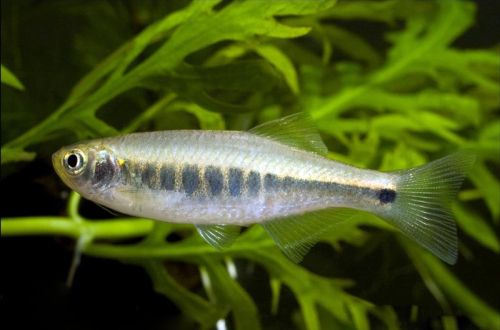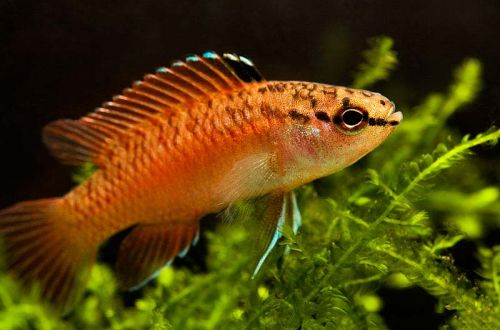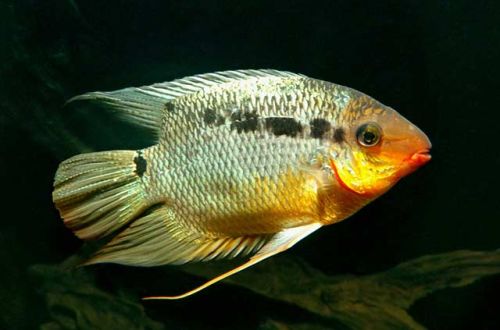
Danio Stealthy
Danio Stealthy, scientific name Danio absconditus, belongs to the Cyprinidae family. Discovered relatively recently in 2015. The name of the species is not associated with the way of life of the fish, but with the fact that it could not be found for a long time, despite the rather good knowledge of the fauna of the habitat of this species.

Contents
Habitat
It comes from Southeast Asia from the territory of the western part of Myanmar (Burma), surrounded on one side by the Arakan mountains, on the other – by the Bay of Bengal. The fish inhabits rivers and streams, originating in the mountains. The natural habitat is changeable, has a pronounced seasonal character associated with the monsoons (May-October).
Brief information:
- The volume of the aquarium – from 40 liters.
- Temperature – 18-26°C
- Value pH — 6.0–7.5
- Water hardness – 2–12 dGH
- Substrate type – any dark
- Lighting – subdued
- Brackish water – no
- Water movement – light or moderate
- The size of the fish is about 5-6 cm.
- Feeding – any food of suitable size
- Temperament – peaceful
- Content in a group of 10 individuals
Description
Adult individuals reach a length of about 5–6 cm. The color is silvery with a dark longitudinal stripe separated by golden strokes. There is a black dot at the base of the tail. When in a group, the alpha male acquires a more saturated color. Sexual dimorphism is weakly expressed.
Food
Undemanding to the diet, it accepts popular foods intended for aquarium fish – these are dry flakes, granules, live or frozen bloodworms, brine shrimp, daphnia, etc.
Maintenance and care, arrangement of the aquarium
The optimal size of the aquarium for a small flock of fish starts from 100 liters. A good choice is a design that resembles the natural habitat of Danio the Secretive. Namely: an abundance of aquatic plants, dark rocky ground with several large boulders and snags. The lighting is subdued. Moderate flow is welcome.
During maintenance, it is important to ensure a consistently high water quality with suitable hydrochemical parameters (pH and dGH values) for the species. Of key importance in this is equipping the aquarium with a productive filtration system and regular maintenance procedures, in particular: weekly replacement of part of the water with fresh water, cleaning the soil and decoration elements from organic plaque, waste (food leftovers, excrement), etc.
Important! The fish is prone to jumping out, so the aquarium should be equipped with a protective cover.
Behavior and Compatibility
Movable peaceful fish. Compatible with many other types of comparable size. It is worth avoiding a settlement with very small and timid fish, for which overly active Danios can become a problem.
They prefer to be in a flock of 10 or more individuals. The more, the more spectacular Danio Skrytny look.
Breeding / breeding
In the natural environment, spawning occurs during the rainy season, when food is plentiful, and flooded areas of the rainforest provide an excellent refuge for juveniles. The incentive for spawning in a home aquarium can be a decrease in water temperature, which occurs in nature with heavy rainfall. However, fish raised for several generations in an artificial environment are already less sleepy to perceive changes in external conditions, so reproduction can occur spontaneously.
Like most cyprinids, Danios scatter a lot of eggs among the thickets of plants and do not take care of their offspring. The incubation period lasts about a week. The fry that appear begin to swim after another 1-2 days.
It is worth noting that adult fish will, on occasion, feast on their own fry, and in order to protect them, juveniles should be moved to a separate tank with identical water conditions to the main aquarium, equipped with a simple airlift filter and heater. A separate light source is not required. Feed with specialized powdered feed, if possible – Artemia nauplii.
Fish diseases
In a balanced aquarium ecosystem with species-specific conditions, diseases rarely occur. Often, diseases are caused by environmental degradation, contact with sick fish, and injuries. If this could not be avoided and the fish shows clear signs of illness, then medical treatment will be required. Read more about symptoms and treatments in the Aquarium Fish Diseases section.





